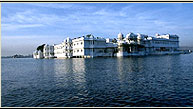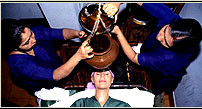-| Agra Tour | -
 Agra
is situated at the banks of river Yamuna and Under the Mughals Agra was the
capital of India (16th and 17th century) It is the town of the magnificent
fort and buildings. Agra is the typical north Indian city with high population
and crowded roads.
Agra
is situated at the banks of river Yamuna and Under the Mughals Agra was the
capital of India (16th and 17th century) It is the town of the magnificent
fort and buildings. Agra is the typical north Indian city with high population
and crowded roads.
The various places of interest are
-
- Taj Mahal
The Taj Mahal was built in Agra, Once the capital of the Mughal Empire during
the 16th and early 18th centuries. Agra, in the state of Uttar Pardesh,
is one and a half hours by express train from New Delhi. This most famous
Mughal monument has been described as the most extravagant monument ever
built for love. Taj Mahal means "Crown Palace" and in fact the most well
preserved and architecturally beautiful tomb in the world.
The postcard picture of Taj Mahal dose not adequately convey the legend,
the poetry and the romance that shroud what Rabindernath Tagore calls "a
teardrop on the cheek of time" It is best described by the English poet.
Sir Edvin Arnold, as " not a piece of architecture, as other buildings are,
but the proud passion of an emperor's love wrought in living stones." It
is celebration of women built in marble and that's the way to appreciate
it.
When Mumtaj Mahal was still alive, she extracted four promises from the
emperor: first, that he build the Taj; second, that he should marry again;
third, that he be kind to their children; and fourth, that he visit the
tomb on her death anniversary. He kept the first and second promises. Construction
began in 1631 and was completed in 22 years. Twenty thousand people were
deployed to work on it. It was designed by the Iranian architect Island
Usa and it is the best appreciated when the architecture and its adornments
are linked to the passion that inspired it. It is a "symbol of eternal love".
As a tribute to beautiful women and as monument for enduring love, the Taj
reveals its subtleties when one visits it without being in a hurry. The
rectangular bass of Taj is in itself symbolic of the different sides from
which to view a beautiful women. The main gate is like a veil to women's
face which should be lifted delicately gently and without haste on the wedding night. In Indian tradition the veil is lifted gently
to reveal the beauty of the bride. As one stands inside the main gate of
Taj, his eyes are directed to the arc which frames the Taj . The dome is
made of White marble ,but the tomb is set against the plain across the river
and it is this background that works its magic of colors that, through their
reflection changes the view of Taj. The color changes ay the different hours
of the day and during different seasons. Like a jewel, the Taj sparkles
in the moonlight when the semi precious stones inlaid into the White Marble
on the main mausoleum catch the glow of the moon. The Taj is pinkish in
the morning,Milky White in the evening and Golden when the sun shines .
These changes they say depict the different moods of Woman.
haste on the wedding night. In Indian tradition the veil is lifted gently
to reveal the beauty of the bride. As one stands inside the main gate of
Taj, his eyes are directed to the arc which frames the Taj . The dome is
made of White marble ,but the tomb is set against the plain across the river
and it is this background that works its magic of colors that, through their
reflection changes the view of Taj. The color changes ay the different hours
of the day and during different seasons. Like a jewel, the Taj sparkles
in the moonlight when the semi precious stones inlaid into the White Marble
on the main mausoleum catch the glow of the moon. The Taj is pinkish in
the morning,Milky White in the evening and Golden when the sun shines .
These changes they say depict the different moods of Woman.
Different people have different view of the Taj but it would be enough to
say that Taj have life of its own that leaps into the Marble, provided you
understand that it is a monument of Love. As an architectural masterpiece,
nothing could be added or subtracted from it.
- Agra Fort
Situated at the banks of river Yamuna this massive red sandstone fort was
built by king Akbar in 1565 AD. The fort is a small city within a city, there is a white Marble pearl mosque which is one of most beautiful
mosque in India.
city, there is a white Marble pearl mosque which is one of most beautiful
mosque in India.
- Diwan-i-am
was built by Shah Jahan it is the hall where King use to attend his public
audiences, besides Diwan-i-am is the small Nagina Masjid (Gem Masque) and
ladies Bazar where female merchant came to sell goods to the ladies of the
Mughal court.
- Diwan-i-Khas
was built by Shah Jahan for his meetings with his private audiences, it
is the place where the famous Peacock throne was kept before being moved
to Delhi by Aurangzeb.
- Octagonal tower
This is the place where Shah Jahan died, the Tower looks over the Yamuna
and its considered as one of the most poignant views of the Taj Mahal.
- Jehangar's Palace
is believed to be built by Akbar, this palace displays an interesting blend
of Hindu and central Asian architectural styles.
- Jama Masjid
it was built by Shah Jahan in 1648 AD. In the name of his daughter Jahanara.
Other buildings of Agra are Khas Mahal, Shish Mahal, Anguri Bagh, Hauz-i-Jehangri,
Amar Singh Gate and etc.
Agra Tour, Indian Cities
Guide Reservation Form




 Agra
is situated at the banks of river Yamuna and Under the Mughals Agra was the
capital of India (16th and 17th century) It is the town of the magnificent
fort and buildings. Agra is the typical north Indian city with high population
and crowded roads.
Agra
is situated at the banks of river Yamuna and Under the Mughals Agra was the
capital of India (16th and 17th century) It is the town of the magnificent
fort and buildings. Agra is the typical north Indian city with high population
and crowded roads. haste on the wedding night. In Indian tradition the veil is lifted gently
to reveal the beauty of the bride. As one stands inside the main gate of
Taj, his eyes are directed to the arc which frames the Taj . The dome is
made of White marble ,but the tomb is set against the plain across the river
and it is this background that works its magic of colors that, through their
reflection changes the view of Taj. The color changes ay the different hours
of the day and during different seasons. Like a jewel, the Taj sparkles
in the moonlight when the semi precious stones inlaid into the White Marble
on the main mausoleum catch the glow of the moon. The Taj is pinkish in
the morning,Milky White in the evening and Golden when the sun shines .
These changes they say depict the different moods of Woman.
haste on the wedding night. In Indian tradition the veil is lifted gently
to reveal the beauty of the bride. As one stands inside the main gate of
Taj, his eyes are directed to the arc which frames the Taj . The dome is
made of White marble ,but the tomb is set against the plain across the river
and it is this background that works its magic of colors that, through their
reflection changes the view of Taj. The color changes ay the different hours
of the day and during different seasons. Like a jewel, the Taj sparkles
in the moonlight when the semi precious stones inlaid into the White Marble
on the main mausoleum catch the glow of the moon. The Taj is pinkish in
the morning,Milky White in the evening and Golden when the sun shines .
These changes they say depict the different moods of Woman. city, there is a white Marble pearl mosque which is one of most beautiful
mosque in India.
city, there is a white Marble pearl mosque which is one of most beautiful
mosque in India.